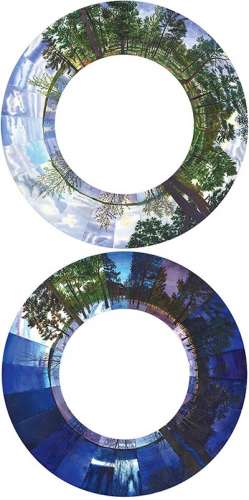“Perhaps the passage of time is a kind of healing, or a kind of salvation granted equally to all people.”—Mizuki Nomura
Inari, Finland, is the cultural center of the Sami – the indigenous people of northern Scandinavia and Russia. At 68.9050 degrees N, 27.0303 degrees E, it lies 225 miles north of the Arctic Circle, in a region where the sun can remain above or below the horizon for 24 continuous hours during the solstices.
Inari is one of seven sites Ken Leslie chose for his Arctic Cycle series. With an award in hand for independent research from the American-Scandinavian Foundation, Leslie set out to spend the summer of 2008 and winter of 2009 interpreting what he saw. The result was a pair of large, circular watercolor paintings that simultaneously reflect time and space. Each wheel represents the cycle of two days, one at the summer solstice and one, six months later, at the winter solstice. The paintings on paper are each folded into 24 sections, accordion style. When open, the piece is an unbroken circle, and when folded up it forms a book that can be held in the hand and read page-by-page, day -by-day. Leslie painted one section an hour for 24 consecutive hours, pivoting in the exact same spot to record the 360-degree panorama.
As you look at these landscapes, you are watching the day pass in a place where the shape and tilt of the earth seems particularly evident. The nontraditional “doughnut” shape helps to focus the attention on the point of view. The center is the viewer (and the artist) looking at the world truly around them – a fundamentally different experience than looking at a traditional rectangular landscape with a horizon line. Leslie’s Arctic Cycle paintings are set to a circadian rhythm, a 24-hour cycle that continues regardless of conditions, including the constant light of mid-summer and the constant darkness of mid-winter.
Leslie’s artistic expression of the landscape in the Arctic is born of a love of the place. Of the dark days, he said, “What the Arctic in winter loses in direct sunlight it gains in twilight – the most amazing range of rich indigos and French ultramarines and cobalts. The intensity of this blue seems greatest when there’s cloud cover, and what little light there is reverberates back and forth between sky above and snow bed below. The filtered light seems to multiply in saturation, and you feel as if you’re walking through blue – not merely below it or in front of it. You breathe it in, bathe in it, become a part of it.”


